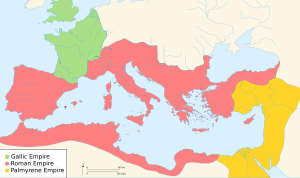
Back Krisis van die Derde Eeu Afrikaans Reichskrise des 3. Jahrhunderts ALS أزمة القرن الثالث Arabic Crisis del sieglu III AST Üçüncü əsr böhranı Azerbaijani Крызіс Рымскай імперыі III стагоддзя Byelorussian Криза в Римската империя Bulgarian Anarkiezh Roma Breton Crisi del segle III Catalan Krize třetího století Czech
| Crisis of the Third Century | ||||||||||
|---|---|---|---|---|---|---|---|---|---|---|
 The divided Empire in 271 AD. | ||||||||||
| ||||||||||
| Belligerents | ||||||||||
| Roman Empire[a] | Roman Breakaways |
Sasanian Empire Germanic Tribes | ||||||||
| Commanders and leaders | ||||||||||
|
|
Shapur I Cniva † | |||||||||
The Crisis of the Third Century, also known as the Military Anarchy[1] or the Imperial Crisis (235–284), was a period in Roman history during which the Roman Empire had nearly collapsed under the combined pressure of repeated foreign invasions, civil wars and economic disintegration. At the height of the crisis, the Roman state had split into three distinct and competing polities.
The crisis began in 235 with the assassination of Emperor Severus Alexander by his own troops. During the following years, the empire saw barbarian invasions and migrations into Roman territory, civil wars, peasant rebellions and political instability, with multiple usurpers competing for power. This led to the debasement of currency and a breakdown in both trade networks and economic productivity, with the Plague of Cyprian contributing to the disorder. Roman armies became more reliant over time on the growing influence of the barbarian mercenaries known as foederati. Roman commanders in the field, although nominally loyal to the state, became increasingly independent of Rome's central authority.
During the crisis, there were at least 26 claimants to the title of emperor, mostly prominent Roman generals, who assumed imperial power over all or part of the empire. The same number of men became accepted by the Roman Senate as emperor during this period and so became legitimate emperors. By 268, the empire had split into three competing states: the Gallic Empire (including the Roman provinces of Gaul, Britannia and, briefly, Hispania); the Palmyrene Empire (including the eastern provinces of Syria Palaestina and Aegyptus); and, between them, the Italian-centered Roman Empire proper.
The reign of Aurelian (270–275) marks a turning point in the crisis period. Aurelian successfully reunited the empire by defeating the two breakaway states, and carried out a series of reforms which helped restore some measure of stability to the Roman economy. The crisis is said to have ended with Diocletian and his restructuring of the Roman imperial government, economy and military. The last is seen as a pivotal moment in Roman history, signaling the beginning of the Dominate.
The crisis resulted in such profound changes in the empire's institutions, society, economic life, and religion that it is increasingly seen by most historians as defining the transition between the historical periods of classical antiquity and late antiquity.[2]
Cite error: There are <ref group=lower-alpha> tags or {{efn}} templates on this page, but the references will not show without a {{reflist|group=lower-alpha}} template or {{notelist}} template (see the help page).
- ^ van Sickle, C. E. (1930). "Particularism in the Roman Empire during the Military Anarchy". American Journal of Philology. 51 (4): 343–357. doi:10.2307/289894. JSTOR 289894.
- ^ Brown, Peter Robert Lamont (1971). The World of Late Antiquity. London: Thames and Hudson. p. 22. ISBN 978-0500320228.